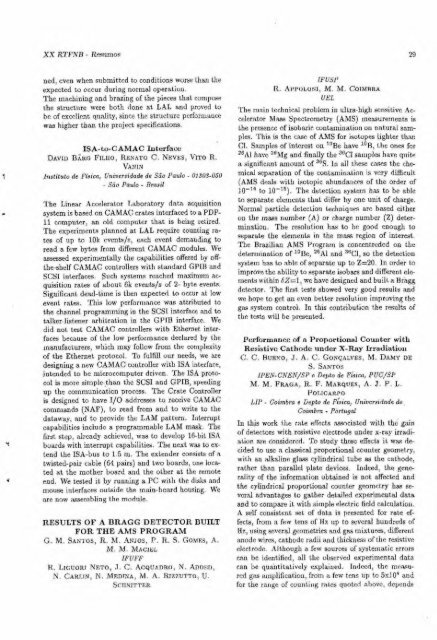REINA() DE TRABALHO SOBRE FiSICA NUCLEAR NO BRASIL
REINA() DE TRABALHO SOBRE FiSICA NUCLEAR NO BRASIL
REINA() DE TRABALHO SOBRE FiSICA NUCLEAR NO BRASIL
Create successful ePaper yourself
Turn your PDF publications into a flip-book with our unique Google optimized e-Paper software.
XX RTENB - Resumos 29<br />
ned, even when submitted to conditions worse than the<br />
expected to occur during normal operation.<br />
The machining and brazing of the pieces that compose<br />
the structure were both done at LAL and proved to<br />
be of excellent quality, since the structure performance<br />
was higher than the project specifications.<br />
ISA-to-CAMAC Interface<br />
DAVID BAItG FILII0, RENATO C. NEVES, VITO R..<br />
VANIN<br />
Institute de Fisica, Universidade de Sao I'aulo - 01303- 050<br />
- Sao Paulo - Brasil<br />
The Linear Accelerator Laboratory data acquisition<br />
system is based on CAMAC crates interfaced to a PDP-<br />
11 computer, an old computer that is being retired.<br />
The experiments planned at LAL require counting rates<br />
of up to 10k events/e, each event demanding to<br />
read a few bytes from different CAMAC modules. We<br />
assessed experimentally the capabilities offered by offthe-shelf<br />
CAMAC controllers with standard GPIB and<br />
SCSI interfaces. Such systems reached maximum acquisition<br />
rates of about fik eveuts/s of 2- byte events.<br />
Significant dead-time is then expected to occur at low<br />
event rates. This low performance was attributed to<br />
the channel programming in the SCSI interface and to<br />
talker listener arbitration in the GPIB interface. We<br />
did not test CAMAC controllers with Ethernet interfaces<br />
because of the low performance declared by the<br />
manufacturers, which may follow from the complexity<br />
of the Ethernet protocol. To fulfill our needs, we are<br />
designing a new CAMAC controller with ISA interface,<br />
intended to be microcomputer driven. The ISA protocol<br />
is more simple-than the SCSI and GPIB, speeding<br />
up the communication process. The Crate Controller<br />
is designed to have I/O addresses to receive CAMAC<br />
commands (NAF), to read from and to write to the<br />
dataway, and to provide the LAM pattern. Interrupt<br />
capabilities include a programmable LAM mask. The<br />
first step, already achieved, was to develop 16-bit ISA<br />
boards with interrupt capabilities. The next was to extend<br />
the ISA-bus to 1.5 in. The extender consists of a<br />
twisted-pair cable (64 pairs) and two boards, one located<br />
at the mother board and the other at the remote<br />
end. We tested it by running a PC 'with the disks and<br />
mouse interfaces outside the main-board housing. We<br />
are now assembling the module.<br />
RESULTS OF A BRAGG <strong>DE</strong>TECTOR BUILT<br />
FOR THE AMS PROGRAM<br />
Cr. M. SANTOS, R. M. ANJOS, P. R. S. COMES, A.<br />
M. Al. MACIEL<br />
IFUFF<br />
It. LIGUORI NETO, J. C. ACQUADRO, N. AnnED,<br />
N. CARLIN, N. IVERDINA, M. A. RIZZUTTO,<br />
SCTINITTER<br />
IFUSP<br />
It. APPoLos:1, M. M. COIMBRA<br />
UEL<br />
The main technical problem in ultra-high sensitive Accelerator<br />
Mass Spectrometry (AMS) measurements is<br />
the presence of isobaric contamination on natural samples.<br />
This is the case. of AMS for isotopes lighter than<br />
Cl. Samples of interest on 10Be have 13 13, the ones for<br />
26AI have 26Mg and finally the 36C1 samples have quite<br />
a significant amount of 36S. In all these cases the chemical<br />
separation of the contamination is very difficult<br />
(AMS deals with isotopic abundances of the order of<br />
10' to 10 -16). The detection system has to be able<br />
to separate elements that differ by one unit of charge.<br />
Normal particle detection techniques are based either<br />
on the mass number (A) or charge number (Z) determination.<br />
The resolution has to he good enough to<br />
separate the elements in the mass region of interest.<br />
The Brazilian AMS Program is concentreded on the<br />
determination of "Be, 26A1 and 36C1, so the detection<br />
system has to able of separate up to Z=20. In order to<br />
improve the ability to separate isobars and different elements<br />
within VZ=1, we have designed and built a Bragg<br />
detector. The first tests showed very good results and<br />
we hope to get an even better resolution improving the<br />
gas system control. In this contribution the results of<br />
the tests will be presented.<br />
Performance of a Proportional Counter with<br />
Resistive Cathode under X-Ray Irradiation<br />
C. C. BUEN0, J. A. C. GONcALVES, M. DAMY <strong>DE</strong><br />
S. SANTOS<br />
IPEN-CNEN/SP e Dept,, de. Figiea, PUC/SP<br />
M. M. FRAGA, R. P. MARQUES, A. J. P. L.<br />
POLICARPO<br />
LII' - Coimbra e Depto de Fivica, Universidade de,<br />
Coimbra - Portugal<br />
In this work the rate effects associated with the gain<br />
of detectors with. resistive electrode under x-ray irradiation<br />
are considered. To study these effects it was decided<br />
to use a classical proportional counter geometry,<br />
with an alkaline glass cylindrical tube as the cathode,<br />
rather than parallel plate devices. Indeed, the generality<br />
of the information obtained is not affected and<br />
the cylindrical proportional counter geometry has several<br />
advantages to gather detailed experimental data<br />
and to compare it with simple electric field calculation.<br />
A self consistent set of data is presented for rate effects,<br />
from a few tens of liz up to several hundreds of<br />
Liz, using several geometries and gas mixtures, different.<br />
anode wires, cathode radii and thickness of the resistive<br />
electrode. Although a few sources of systematic errors<br />
can be identified, all the observed experimental data<br />
can he quantitatively explained. Indeed, the measured<br />
gas amplification, from a few tens up to 5x10 4 and<br />
for the range of counting rates quoted above, depends
















